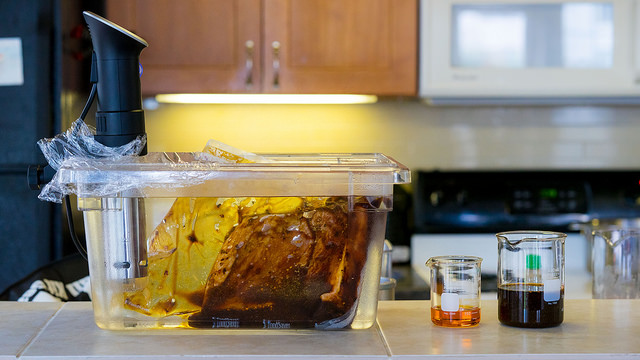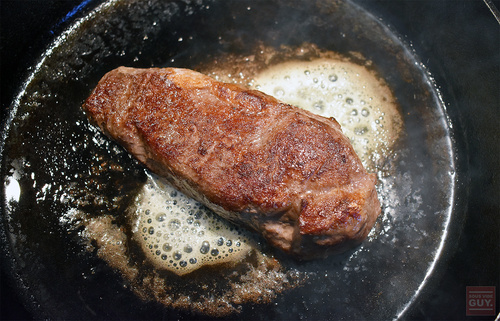Does sous vide cooking seem like it's all the rage in the food industry these days? You've likely seen it on TV or in food magazines and blogs, but weren't quite sure how to do it yourself.
We sat down with Derek Gaughan, founder of the site Sous Vide Guy, to learn what sous vide cooking is all about, and how you can get started at home.

CC: Sous vide cooking is increasingly featured in cooking magazines and blogs. Why is it generating such a buzz?
DG: Sous vide has been around for quite some time in very high-end restaurants. Top chefs and restaurants around the world quickly realized the benefits of sous vide, including tenderness and perfectly cooked dishes from center to edge; however, the initial cost investment used to be a big bite to chew. Thanks to technology and a few start-up “connected kitchen” companies, sous vide has become a new-age cooking phenomenon.
CC: What do I need to sous vide at home? What are the costs associated with getting started?
DG: There are two primary types of sous vide machines.
The first is an all-in-one machines which technically includes everything you need to get started. Prices generally range from $150 - $450, with the better quality machines typically around the $350 mark. Our top recommendation is the Anova Culinary Sous Vide Precision Cooker, available on Amazon.
The second is a new trend in sous vide cooking, immersion circulators. These devices are significantly smaller, some of which can even fit in your kitchen drawer. Circulators are placed inside of an ordinary pot or container of water and heat the water to an exact temperature while also circulating the water to ensure temperature consistency. Immersion Circulators are much cheaper than all-in-one solutions, typically ranging in cost from $100 - $200.
Regardless of which device you pick, you will also need food-safe bags in which to place your food while cooking. It is often recommended to use a vacuum sealer to enclose your food in the bag; however, this isn't necessary. If you don't want to invest in a vacuum sealer, you can simply use a heavy-duty Ziploc bag and use the water displacement method. That’s just a fancy physics term for submerging the bag partially under water (with the top of the bag still open) and letting the air escape from the bag as water pushes it out. You then seal the bag.
CC: Can I sous vide my vacuum-sealed beef without seasoning? When is the best time to season the beef?
DG: Absolutely. Seasoning varies by the cut of meat. For large roasts I often use a combination of salt, pepper, garlic powder, paprika, etc. For steaks, I use salt and pepper only. Most cooks often season the meat it beforehand, place it in the bag, and then sous vide it. However seasoning is completely optional – you can absolutely sous vide beef (without seasoning) first and add a sprinkle of salt before serving. Moreover, I rarely season dry-aged steaks at all before cooking them sous vide since I enjoy experiencing the natural, buttery flavor that comes from dry aging.
CC: Can I overcook my beef when using the sous vide method?
DG: No! This is one of the amazing benefits of sous vide – it’s nearly impossible to mess up. You can cook a steak at 135F for 1 hour or 4 hours. Regardless of when you take it out, the steak will be 135F from edge to center. The only thing that changes during time is tenderness. A steak cooked for 24 hours will be too tender and almost pull apart, which is not ideal. However, this is amazing for other cuts such as pork shoulders when making pulled pork.
CC: I like a nice caramelized sear on my steaks. Can I get that with sous vide?
DG: Yes! Once your steak is finished cooking sous vide, your next task is to get a HOT and FAST sear. The most recommended method is using a cast iron pan with a high smoke point oil, such as avocado oil (500F smoke point). Pre-heat the pan until it’s really hot and sear the steak quickly. If you want an even thicker crust, kitchen torches are often used with sous vide to help develop the exterior sear without worrying about overcooking the center.

CC: Are there any drawbacks of sous vide cooking?
DG: There is only one minor drawback in my opinion: planning. Since sous vide cooking takes a bit longer to cook (1-2 hours for steaks or 24+ hours for pulled pork), you will need to plan ahead. If you’re the type that waits until you’re hungry to decide what’s for dinner, sous vide will leave you drooling as you watch it cook for an hour or two. Relatedly, cooking multiple foods (such as salmon and asparagus) with sous vide can be a bit difficult unless you have multiple machines. Salmon and asparagus need to be cooked at different temperatures, so some balancing must be made to do both with one machine. This can be achieved by first cooking the asparagus for 45 minutes at ~185F, then lowering the temperature to ~130F for salmon (while leaving the asparagus in the water to remain hot).
CC: What is your favorite meal to prepare sous vide?
DG: My favorite is absolutely tri-tip steaks. These large cuts of steak are traditionally a bit tough, which means they are pretty cheap to pick up at your local butcher. Sous vide turns tri-tip steaks into mouth-watering, tender cuts of beef that cannot be beat for the price. I highly recommend this!